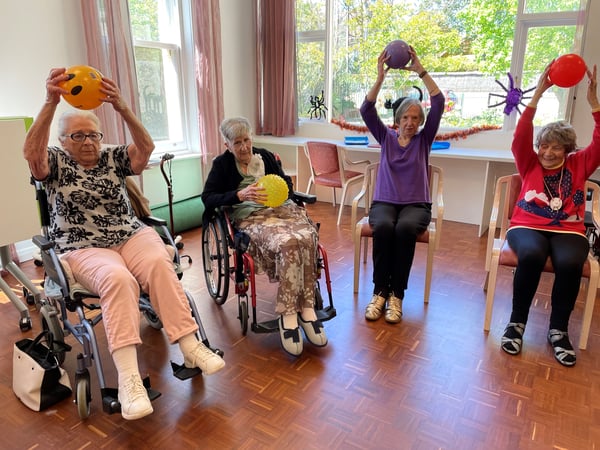Skilled nursing facilities that achieve a five-star rating with the Centers for Medicare and Medicaid Services (CMS) presumably offer above-average quality, while those with only one star likely provide a much lower quality environment. Staffing plays a key role in achieving a higher rating. However, like other healthcare facilities, skilled nursing also suffers from staffing shortages, making it challenging to excel in this portion of the rating criteria. Vivian shares some tactics to improve hiring in skilled nursing facilities to help you achieve a five-star rating.
What Is a Skilled Nursing Facility?
Skilled nursing facilities, often referred to as nursing homes, are residential facilities where patients/residents receive 24/7 skilled nursing care from registered nurses (RNs) and related care from licensed practical or licensed vocational nurses (LPNs/LVNs) and/or nurse aides. According to the CMS, these facilities primarily provide inpatient skilled nursing and related services to patients requiring nursing, medical or rehabilitative services but don’t need the level of care provided in a hospital. Patients in skilled nursing facilities may be elderly or disabled and receiving long-term care or temporary residents receiving short-term rehabilitative services until they’re healthy enough to return home.

What Is a Five-Star Rating with CMS?
The CMS Five-Star Nursing Home Quality Rating System provides an overall rating between one and five based on a skilled nursing facility’s performance in three distinct areas. The facility also receives one to five stars within each of these three areas, including:
- Health inspection ratings that measure the outcomes of unannounced state health inspections performed onsite, usually at least once annually
- Staffing ratings that measure facility staffing levels based on six components
- Quality measures ratings based on resident-level quality measures, including performance on 8 long-stay and 3 short-stay quality measures out of 18 total measures
The core of a facility’s overall star rating is its health inspection rating, but it can be adjusted up or down based on quality measures and whether it has a high or low staffing rating.
How Does Staffing Impact Your CMS Five-Star Rating?
Revisions to the staffing rating occurred in July 2022. Instead of two staffing measures, six measures now impact your facility’s CMS star rating. Ranking poorly in any of the six categories can lower your staffing rating, which can keep you from earning a composite five-star rating. Staffing measures include:
- Total RN, LPN/LVN and nurse aide staffing levels per resident per day
- RN staffing levels per resident per day
- Total weekend RN, LPN/LVN and nurse aide staffing levels per resident per day
- Total RN, LPN/LVN and nurse aide turnover over a 12-month period
- RN turnover over a 12-month period
- Administrator turnover over a 12-month period
As you can see, three measures consider staffing levels, which are case-mix adjusted based on different levels of resident care needs, and the other three deal with turnover. Thus, the recruitment and retention of skilled nursing staff to continually meet the required staffing levels can impact your staffing measure.
Because the staffing star rating carries equal weight for RN staffing levels and total nurse staffing levels, your facility must achieve a five-star rating in both domains to achieve a five-star staffing rating overall. To help ensure your facility earns a five-star rating based on staffing, you must have enough part-time and full-time skilled nursing providers to meet the requirements set by the CMS. Recruitment and retention tactics can significantly impact whether your skilled nursing staff remains large enough to meet these needs.
What Is Skilled Nursing?
Skilled nursing includes a level of care and services that can only be performed by a licensed nurse, either an RN or LPN/LVN. Staff provides for patients’ basic needs, including all activities of daily living. Skilled nursing staff ensures patients’ overall safety and physical comfort to improve their quality of life. Staff also educate patients and their family members on what to expect regarding patients’ specific condition(s) and any challenges they might face. While referrals remain the most productive way of sourcing candidates for skilled nursing positions, there are other ways to help build your staff.

Five Tips to Recruit and Retain Skilled Nursing Staff
Successfully building a skilled nursing staff for your facility hinges on radical recruiting tactics to engage all generations of workers, especially the younger generation. The younger generations, including millennials and Generation Z, are increasingly making up a larger share of the nursing workforce. Attracting younger talent and other age groups to skilled nursing may be more easily achieved with these five tips.
Tip #1: Streamline the Interview Process
Making interviews more efficient is vital to your overall recruitment process. Stretching out the interview process can cause a prime candidate’s interest to wane, and you could lose a prime pick. Set clear expectations of what you’re looking for in a candidate at the very beginning of the interview process to ensure everything you do aligns with these requirements to help streamline each step. Interviews serve two purposes:
-
- Determine whether a candidate would seamlessly fit within your skilled nursing facility
- Make a good impression on a potential hire to encourage them to take the job offered
Unfortunately, many healthcare employers stretch out the interview process, taking the chance that their ideal candidate accepts a position with a competitor before they’ve even had an opportunity to extend a job offer. Speed up the process by:
- Doing a quick pre-screening interview over the phone to gather additional information about the candidates, reduce the amount of time needed for in-person interviews and potentially weed out ill-suited candidates before wasting time in fruitless interviews
- Keeping phone and in-person interviews to a minimum by having a list of must-ask interview questions already prepared and considering supplying candidates with these questions in advance to get the answers you need and avoid overwhelming them
- Asking the same questions and using the same process for every applicant to make it easier to compare them without losing the ability to go off script for more likely candidates to glean valuable additional information
- Avoiding multiple rounds of interviews that aren’t essential to making a decision because you’ve read that a certain number of in-person interviews is the magic number
- Ensuring candidates have all the pertinent information, including the date, time and location of the interview, who will be conducting the interview, whom to ask for when they arrive at the interview location and a contact number in case something delays them or they need to reschedule the interview
Cut down the time it takes to perform other essential parts of the process, such as educational background, criminal history and reference checks, to streamline their entire hiring process and get from initial application to job offer in less time.
Communication is key, so as you go through each step, keep the candidate informed, so they don’t feel like they’ve been ghosted. The best candidates will likely be interviewing for multiple positions with various companies. Once you’ve decided to make a job offer, do so quickly to help avoid losing your preferred choice.
.jpg?width=600&name=pexels-tracy-le-blanc-607812%20(1).jpg)
Tip #2: Leverage Technology
Leveraging technology can help skilled nursing facilities find more suitable candidates quicker, establish better connections with applicants and streamline their recruitment and hiring process. Technology like social media is also excellent for healthcare employer branding, and mobile technology expands a recruiter’s reach and speed of communication.
Social media include popular platforms that many healthcare professionals already utilize to perform job searches, making them obvious choices for attracting talent and recruitment marketing. A primary benefit of social media is advanced targeting tools that let you focus on the right audience through job titles, locations and interests. This perk isn’t found in other types of media. Sharing vital information about skilled nursing staff openings has never been easier.
Mobile apps, texting and chatbots all offer quicker, more interactive ways to communicate and collect data. Mobile devices provide instant responses, increasing the chance of booking an interview to 80%. Applicant response and response times are better, with the open rate for text messages at 98% compared to just 20% for emails. Plus, response rates for text messages are 50 times better than for emails. Recruiter messages that get opened and read further increase the likelihood of a successful connection with a job candidate. Texting and chatting offer easy ways for recruiters to provide prompt responses, keeping candidates engaged, improving their overall experience and potentially boosting your recruiting success rate.
Tip #3: Improve Transparency
The benefits of pay transparency have recently become a hot topic as more laws hit the books requiring companies to reveal their salary ranges. However, more companies use it as a recruiting tactic even without a law in place. Currently, 17 states have some version of a pay disclosure law. While some of these may be statewide, many only pertain to specific cities within the state. The number continues to grow annually as more states strive to pave the way for pay equity.
Pay transparency laws vary but generally require disclosure of the salary range for every position during some point within the hiring process. The newest wave of laws requires employers to include this information in all applicable job postings so candidates know salary data upfront.
Disclosing salary details from the outset helps healthcare employers quickly eliminate those applicants with higher salary expectations than a position provides. It also has the reverse effect in attracting applicants who mistakenly assume a position would offer low pay. Improving your pay transparency is a great way to be proactive during your recruitment process and help your skilled nursing facility stand out when done early in the process.
Besides salary, you can provide even more interest among potential job candidates by being fully open about other things like bonuses, benefits, ancillary support services and opportunities for advancement. If the salary is variable, making it impossible to share an exact hourly rate, provide a pay range or a starting rate and lists of items that make them eligible for a higher salary. Providing a clear idea of what applicants can expect eliminates frustration and poor candidate experiences when it’s discovered late in the hiring process that there’s a significant gap between what was expected versus what’s being offered.
Tip #4: Write Clear Job Descriptions
Another way to be transparent about skilled nursing facility positions is by providing clear job descriptions that fully define the role. Many healthcare employers fall short in adequately defining the exact knowledge and skills required for a position. It’s crucial to create a detailed list of expected duties and required qualifications, including the hard and soft skills necessary to be successful in the role. Other things to add to your job descriptions include:
- Easily understood job titles and keywords
- Accurate hourly rate or salary range
- List of additional benefits
- Details about your company brand and culture
- Prioritized list of clearly defined responsibilities
- Detailed application instructions
Being explicit in your job descriptions discourages unqualified applicants lacking the appropriate knowledge, skills and/or credentials to apply for roles in which they wouldn’t be a good fit. Good job descriptions can also help you draft pertinent interview questions, saving you time in a later stage of the hiring process. Expand your reach by posting your job listings on your company career site, social media and Vivian’s jobs marketplace.

Tip #5: Create Flexibility Both Before and After Hire
Flexibility can be one of the most effective tools in recruiting and retaining not only skilled nursing staff but all healthcare professionals. Although many workplaces benefit from the flexibility of working remotely, this generally isn’t an option in hands-on healthcare roles like skilled nursing. However, there are other ways your facility can increase flexibility before and after you hire a new employee.
Before the hire, consider virtual interviewing to save interviewees time and effort by eliminating the need to come to your location for their face-to-face interview. Once hired but before their start date, allow candidates to perform digital onboarding at home before they arrive for in-person orientations to be flexible and check some items off the list before starting their new role.
After the hire, flexibility can include scheduling options to work around an employee’s other responsibilities, primarily their families. Scheduling flexibility for both shifts and days worked and allowing shift swapping provides better shift coverage, frees up time for supervisors responsible for setting schedules and improves staff retention.
Flexible scheduling can also be a persuasive recruiting tool because it allows for a better work-life balance. A solid work-life balance is essential due to the stressful nature of healthcare, especially nursing jobs, and helps boost engagement, staff productivity and job satisfaction.
Healthcare organizations trying to lure and retain talent, especially among the younger generations, must embrace flexibility to succeed in today’s marketplace. Combine flexible work schedules with unlimited PTO and/or vacation time, and you take vital steps in improving your hiring capabilities in your skilled nursing facility and potentially achieving an above-average CMS rating.
Schedule a demo with Vivian Health, and let us help you build a skilled nursing staff that helps your facility reach that coveted five-star rating.
